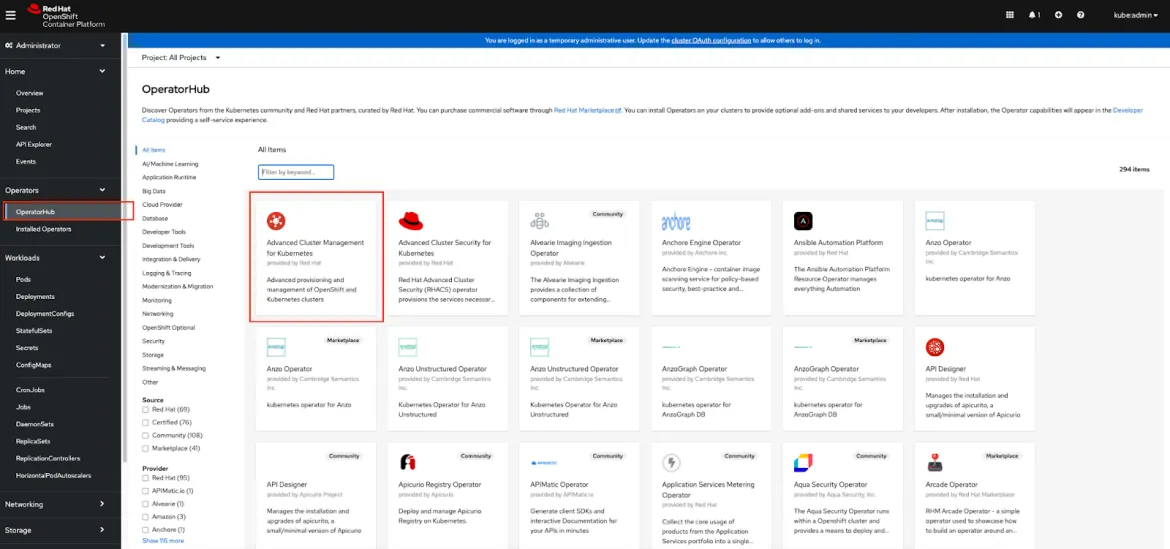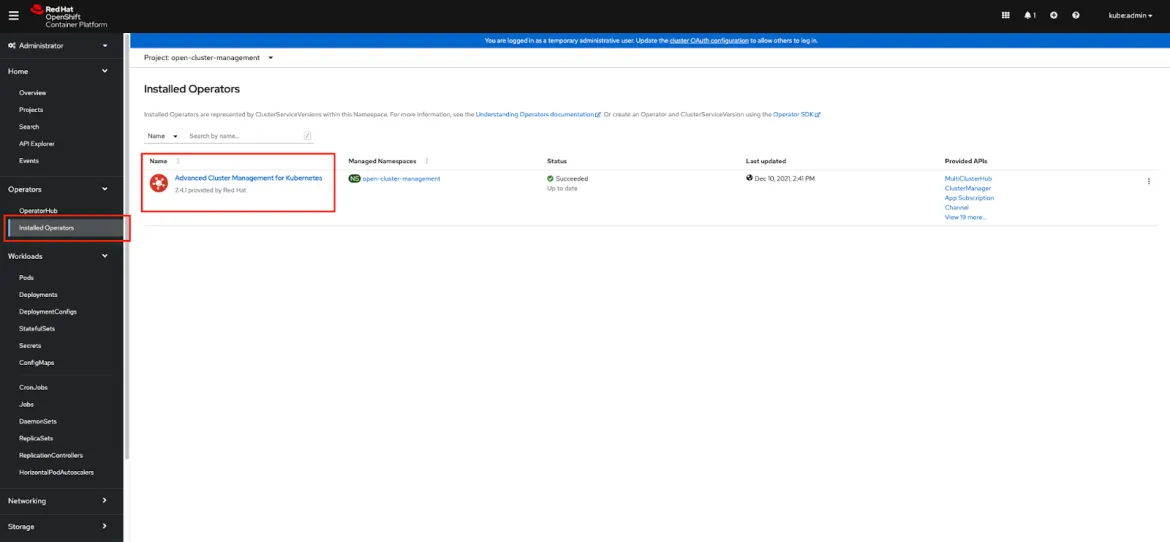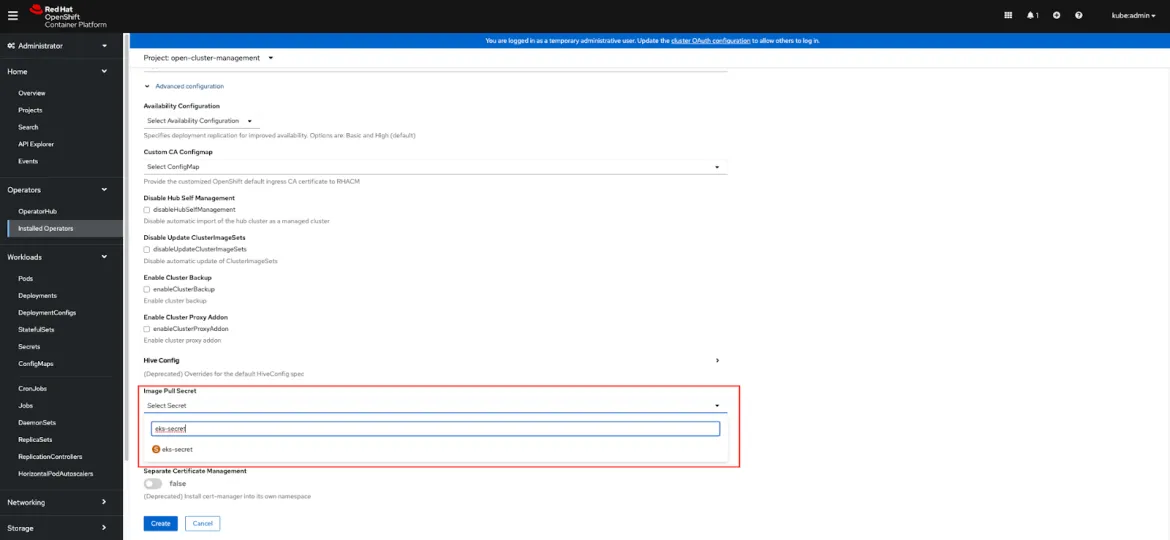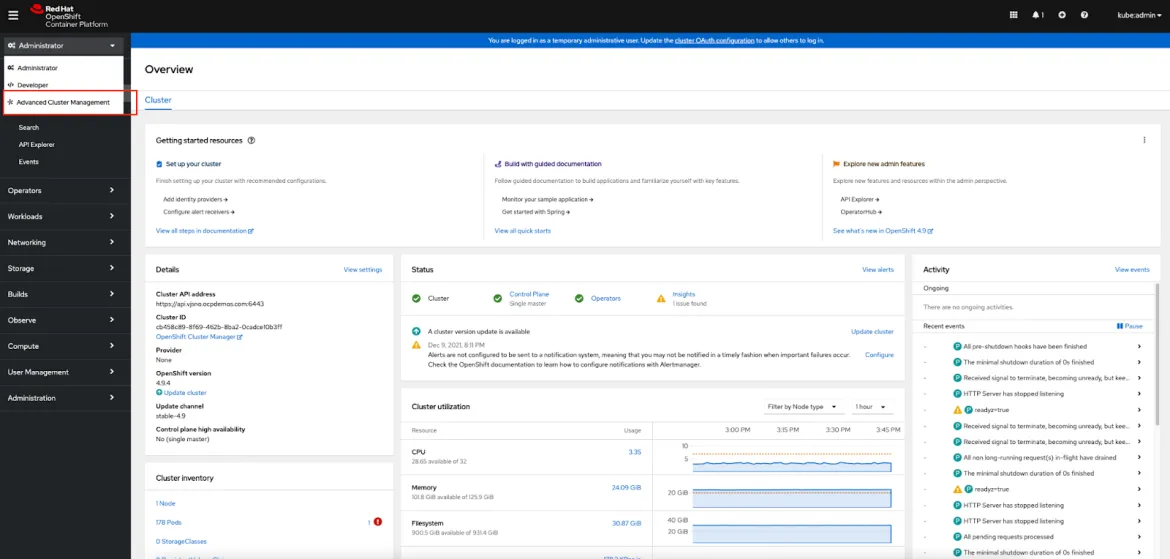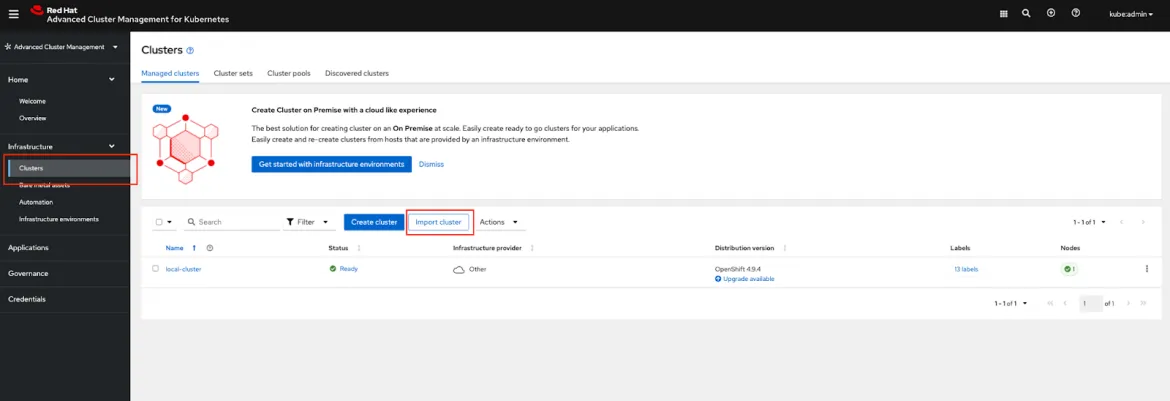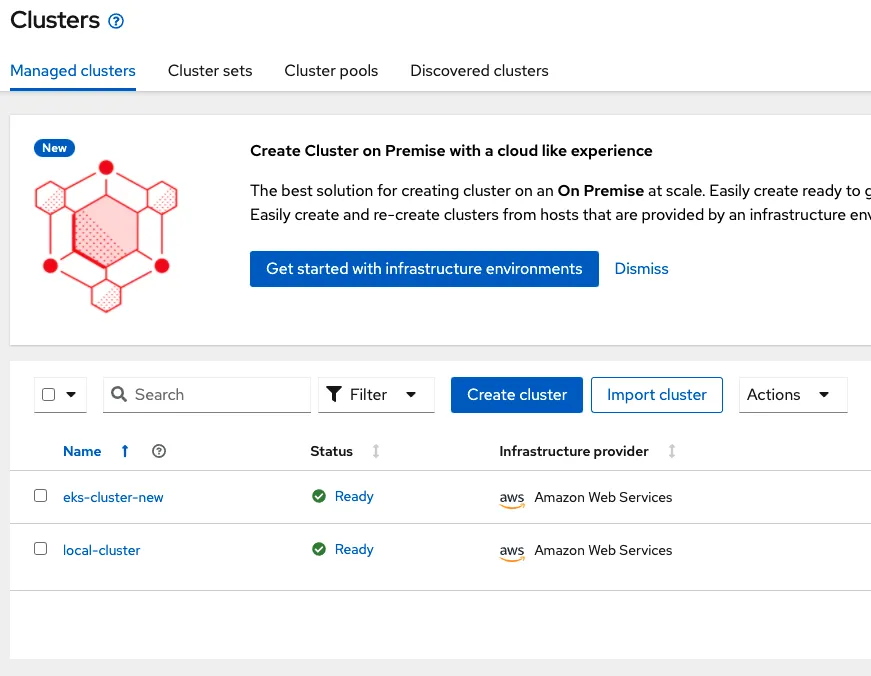Prerequisites
- AWS account
- Red Hat account
- eksctl installed on your local machine
- kubectl installed on your local machine
- oc CLI installed on your local machine
- OpenShift cluster as Hub cluster
Install ACM on OpenShift Hub cluster
Login to the OpenShift Web Console as a Cluster administrator.
Install Red Hat Advanced Cluster Management (ACM) from the OperatorHub within OpenShift Web Console as shown here:
Note: ACM Operator gets installed in the open-cluster-management namespace/project
Download Pull Secret
Login to Red Hat Hybrid Cloud Console with your credentials.
Navigate to Downloads and scroll down to the Tokens section. Select Download to get a copy of your pull secret on your local machine.
Upload Pull Secret to ACM
Login to your OpenShift cluster using oc CLI.
Run the following command to switch to open-cluster-management namespace/project:
$ oc project open-cluster-management
Run the following command to upload the pull secret to open-cluster-management namespace/project:
$ oc create secret generic eks-secret \ --from-file=.dockerconfigjson=pull-secret.txt \
--type=kubernetes.io/dockerconfigjson
eks-secret is the name of the secrets object, and pull-secret.txt is the pull secret downloaded in the previous step.
Install MultiClusterHub
After the ACM Operator gets installed successfully, navigate to “Installed Operators” and select “Advanced Cluster Management for Kubernetes” as shown:
Click on “Create instance” for MultiClusterHub.
Expand “Advanced Configuration”. Scroll down to “Image Pull Secret” and search for the secret uploaded in the previous step (for example, eks-secret). Select this secret and hit “Create”.
Create an EKS cluster
Create a YAMIL file eks-cluster-1.21.yaml with the following information. Save it to your local machine.
apiVersion: eksctl.io/v1alpha5
kind: ClusterConfig
metadata:
name: eks-cluster # EKS Cluster name
region: us-east-2 # Region Code to place EKS Cluster
version: "1.21"
managedNodeGroups:
- name: primary # Name of node group in EKS Cluster
instanceType: t3.small # Instance type for node group
desiredCapacity: 3 # Number of worker nodes- default is 2
Change the config parameter values according to your desired setting. There are many more configuration parameters, which you can find if you type eksctl create cluster –help.
Run the following command, which was used to create an EKS cluster.
$ eksctl create cluster --config-file eks-cluster-1.21.yaml
The above command creates an EKS cluster with worker nodes (EC2 instance type t3.small) in the us-east-2 region using Kubernetes version 1.21
Import EKS cluster
Switch to the “Advanced Cluster Management” view from the OpenShift Web Console:
Select “Clusters” under the Infrastructure menu and select “Import cluster”:
Provide a name for the EKS cluster that will be imported and choose “Run import commands manually” option from the drop down for Import mode:
Select “Save import and generate code”.
Select “Copy command” and run the command from the command line against the EKS cluster.
Your EKS cluster will successfully get imported into ACM.
Sobre los autores
Navegar por canal
Automatización
Las últimas novedades en la automatización de la TI para los equipos, la tecnología y los entornos
Inteligencia artificial
Descubra las actualizaciones en las plataformas que permiten a los clientes ejecutar cargas de trabajo de inteligecia artificial en cualquier lugar
Nube híbrida abierta
Vea como construimos un futuro flexible con la nube híbrida
Seguridad
Vea las últimas novedades sobre cómo reducimos los riesgos en entornos y tecnologías
Edge computing
Conozca las actualizaciones en las plataformas que simplifican las operaciones en el edge
Infraestructura
Vea las últimas novedades sobre la plataforma Linux empresarial líder en el mundo
Aplicaciones
Conozca nuestras soluciones para abordar los desafíos más complejos de las aplicaciones
Programas originales
Vea historias divertidas de creadores y líderes en tecnología empresarial
Productos
- Red Hat Enterprise Linux
- Red Hat OpenShift
- Red Hat Ansible Automation Platform
- Servicios de nube
- Ver todos los productos
Herramientas
- Training y Certificación
- Mi cuenta
- Soporte al cliente
- Recursos para desarrolladores
- Busque un partner
- Red Hat Ecosystem Catalog
- Calculador de valor Red Hat
- Documentación
Realice pruebas, compras y ventas
Comunicarse
- Comuníquese con la oficina de ventas
- Comuníquese con el servicio al cliente
- Comuníquese con Red Hat Training
- Redes sociales
Acerca de Red Hat
Somos el proveedor líder a nivel mundial de soluciones empresariales de código abierto, incluyendo Linux, cloud, contenedores y Kubernetes. Ofrecemos soluciones reforzadas, las cuales permiten que las empresas trabajen en distintas plataformas y entornos con facilidad, desde el centro de datos principal hasta el extremo de la red.
Seleccionar idioma
Red Hat legal and privacy links
- Acerca de Red Hat
- Oportunidades de empleo
- Eventos
- Sedes
- Póngase en contacto con Red Hat
- Blog de Red Hat
- Diversidad, igualdad e inclusión
- Cool Stuff Store
- Red Hat Summit

